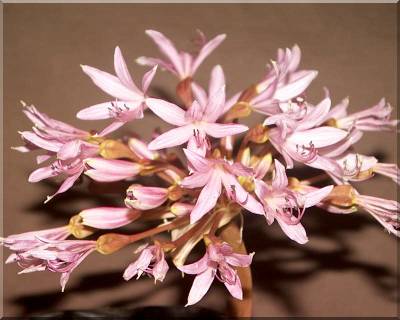

Brunsvigia bosmaniae, Image by
![]() Cameron
McMaster.
Cameron
McMaster.
Brunsvigia has around 20 species* and these grow in all parts of Southern Africa and extend into Topical Africa. Species and varieties include winter and summer growing bulbs. The foliage can vary from dark or medium green, grey-green, wide, undulate, upright or prostrate. Very variable indeed! The flowers can be small, medium or large in umbel size and many glowers go to make up the whole flower. They come in varying shades of white, pinks, reds, cerise and crimson.
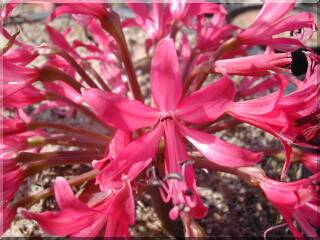
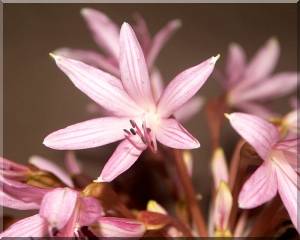
Brunsvigia gregaria (left) growing here at Mainly Amaryllids Garden 2003.
Brunsvigia bosmaniae, in detail. Image
by
![]() Cameron McMaster
Cameron McMaster
Seeds usually form quite easily on this genus. The seeds are sown as soon as they are ripe and are fleshy in nature. I press them into a sandy medium and leave them alone, checking that the weeds have not grown over the small seedlings. These will be ready to plant into a permanent position in their third year and left alone until they flower.
There
is a great deal of work to do in the genus Brunsvigia. This is my small, but,
growing part. It is only through the continued help, of many like minded
enthusiasts, that a major part of my collection would not exist. Brunsvigia
species can vary greatly in size of bulbs and requirements in pot size. The
small bulbs of Brunsvigia comptonii need quite different cultivation compared to
the quite huge bulbs of Brunsvigia josephinae. Although the soils used may be
similar, the pot size is not. B. comptonii will grow quite nicely in a 10"
pot long term. Larger species like B. josephinae needs at least a 30" pot
for long term growing.
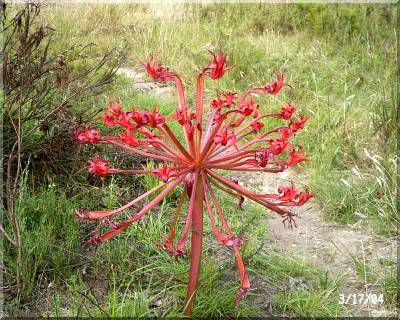
Brunsvigia josephinae in situ, Brenton, East
Cape, South Africa. Image
by
![]() Cameron McMaster
Cameron McMaster
In
most species, the bulb grows underground. Some species will like to grow with
1/2 or 2/3rds of the bulb growing above ground. When in doubt as to how deep to
plant the bulb, a good rule of thumb is plant the bulb higher instead of deeper.
Bulbs can grow down easier than upward. By
doing this, they will grow into the position that the bulbs want to.
Brunsvigia
species require a very well drained soil, preferably a sandy medium. Here in our
climate, I can sow Brunsvigia seeds straight into the ground with very good
results. I use the garden beds do do all the raising of this genus. There is a
need to plant all the seeds in one spot though. Then, in two years time you can
transplant them to their final home in the garden. I am now cultivating all of
my Brunsvigia in the soil found here at Barnawartha. It is a typical clay/sand soil
with very good drainage. The winter growers are in 100% sand beds on top of the
soil. The summer growers are planted directly into it. Small
species (B gregaria, B. comptonii, B Port Elizabeth form) are well suited to pot
cultivation and make excellent conversation subjects. The larger species (B. grandiflora, B. josephinae) as suited to the
open garden and can become quite a spectacular sight in time.

Brunsvigia
species need to be planted and left in that position until they flower. These
bulbs resent moving from one location to another and can be set back 2 years
from flower if the move is too upsetting.
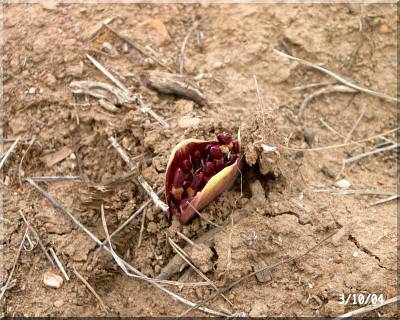
Brunsvigia orientalis emerging bud, 9 March.
2004. Image
by
![]() Cameron McMaster
Cameron McMaster
Be
sure to provide a large pot from the bigger species. The roots on this genus, as
in many other Amaryllids, are large and fleshy. Persistence of these roots will
mean flowering year after year.
I
have tried many different types of food for these gems. I found that a simple
feeding of urea free blood and bone, with a dressing of ash for sweetness, helps
the bulbs along nicely. This is done when the bulbs are first noticed initiating
for the growing season. Sometimes I skip a season and don't feed at all.
As bulbs are Natures adaptation to poor soils they don't even notice.
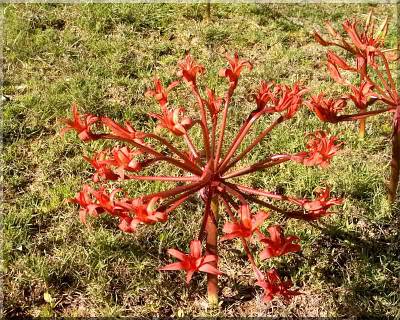
Brunsvigia orientalis Bredasdorp, East Cape,
South Africa. 15Apr. 2004 Image
by
![]() Cameron McMaster
Cameron McMaster
You
have the final say at just how your bulbs will be cultivated. Your garden, like
most, is specific in its needs and you have control over how the plants grow.
The more observations that you can make the better. This all goes towards a
better bloom next season. Also, these notes can apply to the Brunsvigia hybrids
that you can create crossing Amaryllis belladonna back to Brunsvigia. I grow my
Amaryllis belladonna the same way as I treat the Brunsvigia. If you have
anything to add to this, please contact me with your notes and we can compare.
Who knows what we learn? Learning together, with other like-minded bulb
enthusiasts, is what it is all about!
Happy
growing,
Dash.
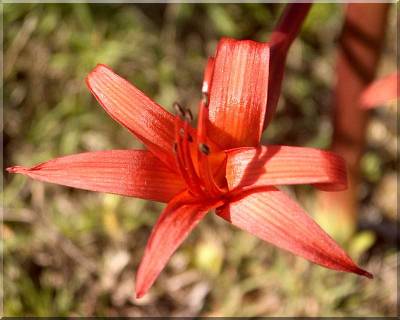
Brunsvigia orientalis in detail, Bredasdorp, East Cape, South Africa. 15Apr. 2004
Image
by
![]() Cameron McMaster
Cameron McMaster
*(Duncan/DuPleiss, Bulbous plants of Southern Africa)
-------------------------------------------------------------------------------------
![]() A
disk of images and cultivation information called 'Wild Bulbs of the Eastern
Cape' is available
from Cameron McMaster. This disk is a highly informative and extremely pictorial
collection, captured by Cameron whilst collecting seeds out in the field.
Cameron McMaster is one of South Africa's most noted naturalists, whose
enthusiasm shines through on this information available. His love of the plants
and the surrounding environment resounds through this disk. I consider myself
very lucky to have a friendship with such a dedicated and personable gentleman.
A
disk of images and cultivation information called 'Wild Bulbs of the Eastern
Cape' is available
from Cameron McMaster. This disk is a highly informative and extremely pictorial
collection, captured by Cameron whilst collecting seeds out in the field.
Cameron McMaster is one of South Africa's most noted naturalists, whose
enthusiasm shines through on this information available. His love of the plants
and the surrounding environment resounds through this disk. I consider myself
very lucky to have a friendship with such a dedicated and personable gentleman.
![]() Order
Wild Bulbs of the Eastern Cape disk
Order
Wild Bulbs of the Eastern Cape disk ![]() Home
Home